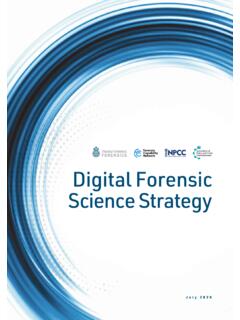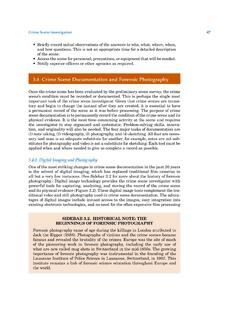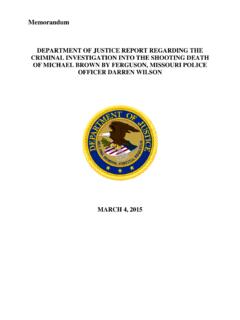Transcription of National Best Practices for Sexual Assault Kits: A ...
1 Department of Justice Office of Justice Programs National Institute of Justice National best Practices for Sexual Assault kits : A Multidisciplinary Approach Department of Justice Office of Justice Programs 810 Seventh St. Washington, DC 20531 Howard Spivak Acting Director, National Institute of Justice This and other publications and products of the National Institute of Justice can be found at: National Institute of Justice Strengthen Science Advance Justice Office of Justice Programs Building Solutions Supporting Communities Advancing Justice The National Institute of Justice is the research, development and evaluation agency of the Department of Justice. NIJ s mission is to advance scientific research, development and evaluation to enhance the administration of justice and public safety. The National Institute of Justice is a component of the Office of Justice Programs, which also includes the Bureau of Justice Assistance; the Bureau of Justice Statistics; the Office for Victims of Crime; the Office of Juvenile Justice and Delinquency Prevention; and the Office of Sex Offender Sentencing, Monitoring, Apprehending, Registering, and Tracking.
2 Opinions or conclusions expressed in this paper are those of the authors and do not necessarily reflect the official position or policies of the Department of Justice. NCJ 250384 Contents Sexual Assault forensic Evidence Reporting (SAFER) Act Working Summary of Recommendations .. ix Chapter 1: Multidisciplinary Chapter 2: The Medical- forensic Exam and Sexual Assault Evidence Chapter 3: Transparency and Accountability of Law Enforcement for Chapter 4: Investigative Chapter 5: Processing Sexual Assault kits in the Laboratory ..53 Chapter 6: Post-Analysis Communication and Policy Considerations ..67 Conclusion ..75 Multidisciplinary Sexual Assault Glossary ..79 Appendix A: Research Supporting Trauma-Informed Care ..107 Appendix B: Federal Government Appendix C: The Persistence of Body Fluids and Appendix D: Recommended High-Throughput Process Flow for Sexual Assault Appendix E: Outsourcing Sexual Assault Appendix F: Highlights of the NIJ Action Research Projects in Detroit and Appendix G: 15 Key Principles for Developing a Victim Notification Protocol.
3 121 Appendix H: Victim Notification Process ..123 National best Practices for Sexual Assault kits : A Multidisciplinary Approach i Sexual Assault forensic Evidence Reporting (SAFER) Act Working Group The SAFER Working Group was developed to address the SAFER ( Sexual Assault forensic Evidence Reporting) Act of 2013, which recommends, in part, the development of best Practices and protocols for the collection and processing of DNA evidence in Sexual Assault The SAFER Working Group, which convened over the course of more than two years, consisted of subject matter experts empaneled by the National Institute of Justice (NIJ) and representing victims, victim advocates, Sexual Assault nurse examiners, medical examiners, forensic laboratories, law enforcement agencies, prosecutors, and the judiciary. The working group considered issues relating to evidence collection; prioritization of evidence and time periods for collection; evidence inventory, tracking, and auditing technology solutions; investigative and policy considerations; and communication strategies.
4 With the diversity of backgrounds and views, the SAFER Working Group successfully reached substantial agreement on a variety of complex issues. A draft of this document was also posted for public comment in August 2016 and received a litany of generally positive feedback along with a number of extremely helpful suggestions. All of the comments were considered, deliberated, and ultimately used to strengthen the document. The recommendations in this document are not mandated by any governing body; they are provided as recommended best Practices based on research, well-established processes from other disciplines, extensive professional experience of the working group members, and input from the public. 1 The Sexual Assault forensic Evidence Reporting Act of 2013 (SAFER Act), 113-4, 1002, (o)(1). National best Practices for Sexual Assault kits : A Multidisciplinary Approach iii SAFER Technical Working Group Members Michelle Arbeit National Institute of Justice Ginger Baran Lyons Office on Violence Against Women (OVW) Hannah Barcus Booz Allen Hamilton Consultant for National Institute of Justice Emily Burton-Blank Center for Victims Amber Carr Federal Bureau of Investigation Laboratory Sonia Corrales Houston Area Women s Center Jennifer Coursey Defense forensic Science Center Brenda Danosky Illinois State Police Kim Day International Association of forensic Nurses Rachell Ekroos Center for forensic Nursing Excellence International Neil Fernandopulle Centre of forensic Science Jodie Flynn Capital University Norm Gahn Office of the District Attorney, Milwaukee County (WI) (Ret.)
5 Kellie Greene Office on Violence Against Women Dawn Herkenham Leidos George Herrin, Jr. Georgia Bureau of Investigation Charles Heurich National Institute of Justice Ted Hunt Jackson County (MO) Prosecutor s Office Kimberly Hurst Wayne County (MI) SAFE Gerald LaPorte National Institute of Justice Heather LaSalle Federal Bureau of Investigation Laboratory Julie Lecea Air Force Office of Special Investigations Mary Lentschke Houston (TX) Police Department Eugene Lien New York City Office of Chief Medical Examiner Jim Markey Phoenix (AZ) Police Department (Ret.), Sex Crimes Unit/Investigative Lead, LLC Beth Ann Marne Pennsylvania State Police Doug McGowen City of Memphis (TN) Pattie Melton RTI International Melissa Mourges Manhattan County (NY) District Attorney s Office iv National Institute of Justice Jeffrey Nye Michigan State Police Anthony Onorato Federal Bureau of Investigation Laboratory Helen Rafaniello New York City Office of Chief Medical Examiner Karyn Rasile Rasile Training and Consulting, LLC Keith (Ronald) Reid Metropolitan Police Department (DC) Ron Reinstein Judicial Consultant, Arizona Supreme Court Lutz Roewer Institute of Legal Medicine and forensic Sciences Kristin Roman New York City Office of Chief Medical Examiner Kris Rose Office for Victims of Crime (OVC) Jordan Satinsky Montgomery County (MD)
6 Department of Police Lisa Schiermeier-Wood Virginia Department of forensic Science Allison Sedowski Independent Consultant Jessica Shaw Boston College Patricia Speck The University of Alabama at Birmingham Jill Spriggs Sacramento County (CA) District Attorney s Office Crime Laboratory Stephanie Stoiloff Miami-Dade (FL) Police Department Melissa Suddeth Florida Department of Law Enforcement Robert Taylor Los Angeles County (CA) Sheriff s Department Julie Valentine Brigham Young University College of Nursing Russell Vossbrink Arizona Department of Public Safety Heather Waltke National Institute of Justice Erica Weber Jacksonville (FL) Sheriff s Office Danielle Weiss Booz Allen Hamilton Consultant for National Institute of Justice Ray Wickenheiser New York State Police Crime Laboratory System The final recommendations contained in this document are the result of a consensus process and do not necessarily represent the views or opinions of the individual working group members or their agencies and affiliations.
7 National best Practices for Sexual Assault kits : A Multidisciplinary Approach v SAFER Editorial Board Hannah Barcus Booz Allen Hamilton Consultant for National Institute of Justice Amber Carr Federal Bureau of Investigation Laboratory Kim Day International Association of forensic Nurses Norm Gahn Office of the District Attorney, Milwaukee County (WI) (Ret.) Kellie Greene Office on Violence Against Women Dawn Herkenham Consultant Gerald LaPorte National Institute of Justice Julie Lecea Air Force Office of Special Investigations Mary Lentschke Houston (TX) Police Department Jim Markey Phoenix (AZ) Police Department (Ret.), Sex Crimes Unit/Investigative Lead, LLC Stephanie Stoiloff Miami-Dade (FL) Police Department Heather Waltke National Institute of Justice Danielle Weiss Booz Allen Hamilton Consultant for National Institute of Justice Writing and Publication Development Amber Carr Federal Bureau of Investigation Laboratory Dawn Herkenham Consultant/Writer Jenifer Markowitz Consultant/Writer Danielle Weiss Booz Allen Hamilton Consultant for National Institute of Justice vi National Institute of Justice Acknowledgments The National Institute of Justice (NIJ) and the Sexual Assault forensic Evidence Reporting (SAFER)
8 Working Group gratefully acknowledge various agencies and individuals for their contributions to the development and review of this document, especially the Federal Bureau of Investigation, the Office on Violence Against Women, the Office for Victims of Crime, and the Bureau of Justice Assistance. Special thanks to Danielle Weiss, Booz Allen Hamilton technical consultant for NIJ, who served as project manager for the SAFER publication and the working group; Amber Carr, Supervisory Biologist with the FBI Laboratory, who chaired the SAFER Editorial Board; Jenifer Markowitz, consultant; and Dawn Herkenham, consultant, for their exceptional writing, development, and publication support. Sponsorship NIJ is the research, development, and evaluation agency of the Department of Justice and is dedicated to researching crime control and criminal justice issues. NIJ provides objective, independent, evidence-based knowledge and tools to meet the challenges of crime and justice.
9 The Office of Investigative and forensic Sciences is the federal government s lead agency for forensic science research and development as well as for the administration of programs that provide direct support to crime laboratories and law enforcement agencies to increase their capacity to process high-volume cases, to provide needed training in new technologies, and to provide support to reduce backlogs. forensic science program areas include Research and Development in Basic and Applied forensic Sciences, the Coverdell forensic Science Improvement Grants, the DNA Backlog Reduction and Capacity Enhancement program, Solving Cold Cases with DNA Grants, Post-Conviction Testing of DNA Evidence to Exonerate the Innocent, Using DNA Technology to Identify the Missing, and the National Missing and Unidentified Persons System (NamUs). National best Practices for Sexual Assault kits : A Multidisciplinary Approach vii Summary of Recommendations The SAFER Working Group developed 35 recommendations through a consensus process.
10 Although the working group acknowledges that every jurisdiction is different, the intent of the following recommendations is to positively impact Sexual Assault responses and the experiences of victims and to ultimately result in safer communities. Chapter 1: Multidisciplinary Approach 1. A collaborative multidisciplinary approach should be implemented for Sexual Assault cases. 2. Sexual Assault responders should use a victim-centered and trauma-informed approach when engaging with victims of Sexual Assault . 3. Agencies should collaborate and involve victim advocates early in the process to create a more victim-centered approach to the criminal justice process. 4. The multidisciplinary approach should seek out and include voices from underserved or vulnerable populations in the community s response to Sexual Assault cases. Chapter 2: The Medical- forensic Exam and Sexual Assault Evidence Collection 5.













